By Lauren Hansen
The first English settlements in the so-called New World were far from glamorous. Indeed, early settlers in Jamestown, Va., were often starving, and forced to eat dogs, mice, and shoe leather to survive devastating winters. A few written accounts take things one gruesome step further and suggest that some colonists even ate their own dead.
Those cannibal rumors, it turns out, are true. A group of archeologists have found proof of our ancestors' stomach-turning eating habits, in the form of a mangled skull that is "absolutely consistent with dismemberment and de-fleshing."
In August 2012, a group of archaeologists digging around a debris-filled cellar on Jamestown Island—a 22.5-acre peninsula just north of the mouth of the Chesapeake Bay—came across the remains of a 14-year-old girl. They also found horse, dog, and squirrel bones, but the real find was the girl's skull, lower jaw, and leg bone—all of which have the distinct marks of an ax or a cleaver.
On the girl's forehead, we can see the choppy, almost hesitant initial markings that failed to pierce the bone. But when turned over, the back of the skull reveals the more effective blow that split the skull all the way to the base.

The forehead and left side of the skull before it was pieced together. Four rough cuts at the top are likely the initial attempts to hack open the girl's head. Photo courtesy Don Hurlbert/Smithsonian/Getty Images.
There are markings along the jaw line that indicate the tongue and facial tissue were removed. There is also a puncture to the left side of the head that was likely used, in a bizarre fashion, to pry it off and extract the brain.
Scientists say this skull provides definitive evidence that colonists were haphazardly trying to remove the facial tissue and brain for consumption. In the 17th century, such flesh from an animal, say, a hog, for example, was actually considered a delicacy, which is why these desperate settlers might have gone straight for the girl's head.
And before you get too woozy: Yes, the girl was dead before they started hacking into her skull. The markings indicate there was no struggle. However, the feast likely went down soon after she died.
"The attempt to [remove] the brain is something you would need to do very quickly because brains do not preserve well," says Dr. Doug Owsley, a forensic anthropologist involved with the dig.
So, what could have happened to this poor girl? Let's investigate:
In 1607, a ragtag group of English adventurers set out to create the first colony in the so-called New World. The explorers landed on Jamestown Island on May 14, establishing the Virginia English colony.
The swampy land was filled with disease-ridden mosquitos, and the settlers didn't have much time to plant ahead of the winter. The newbies were also under constant siege by Native Americans, who had colonized this land long before, and were none too pleased about their new invasive neighbors.
In 1609, a second fleet of ships departed from Plymouth, England, with reinforcements. Seven out of the nine ships managed to survive a deadly hurricane and landed at Jamestown in mid-August. It was on one of these ships, researchers say, that the girl, whom they have named "Jane," likely arrived.
Unfortunately, the new arrivals were more of a hassle than a help. The ships' crews hoarded what food they brought. Jamestown was already suffering from the worst drought in 800 years, and the meager crops the colony managed to grow over the summer were hardly enough to feed the township that was now up to about 300 people.
By October, people were hungry, and life was only getting worse. The subsequent winter would come to be known as The Starving Time.
Studying the fragments of Jane's skull, researchers found an enriched "nitrogen profile," evidence that the girl was at least at one time well nourished, with a diet rich in protein. This suggests that she came from a relatively high class, and that she thus didn't make the trip alone. But with no fresh meat or produce, Jane and her fellow settlers were forced to eat their horses, dogs, cats, rats, and snakes. Some would have even gnawed on the soles of their shoes to satiate the endless hunger.
One contemporary writing tells of a man who killed and ate his pregnant wife. The colony's leader, Capt. John Smith, records the miserable news:
"One amongst the rest did kill his wife, powdered her, and had eaten part of her before it was known, for which he was executed, as he well deserved," Smith wrote. "Now whether she was better roasted, boiled or carbonado'd [barbecued], I know not, but of such a dish as powdered wife I never heard of." [Fox News]
We may never know how many colonists were eaten as the wretched weeks turned to months. But now, thanks to the discovery of Jane, scientists know for certain that it did happen.
After six months of starvation, only 60 colonists survived. Defeated, the meager pack abandoned Jamestown and headed down the James River, intent on returning to England. But relief, leadership, and the seed of our future nation arrived in the form of Lord De La Warr (Yep: Delaware would be his namesake) to stop them. De La Warr, his relief fleet, and 150 new settlers, led the colonists back to the fort where the foundations were laid for a prosperous and cannibal-free future.
The remains of "Jane" as well as her reconstruction will be on display in Jamestown. And with plenty left to forage at the original site, archaeologists will continue to investigate Jane's untimely end, as well as her real identity.
Sources: BBC, Fox News, HistoricJamestown.org, Jamestown Rediscovery Project, The Washington Post
More from The Week...
8 Monarchies that Still Exist
*
*
Why Giving Robots a Sense of Touch is Such a Big Deal
